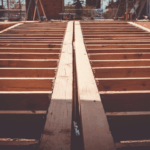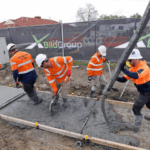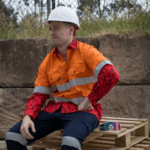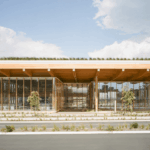Can we build a Home that is Resilient to Floods and Cyclones?
With each year, seeing more and more homes lost and communities torn apart, a team of experts worked to better understand the problems residents are faced with during wild weather events.

GALLERY







Our great southern land is changing. Extreme weather events are rapidly increasing in both duration and frequency, and our communities are taking the hit. Australian homes are becoming increasingly vulnerable due to the effects of climate change, and with each wild event devastating towns and cities, it is also impacting the health and wellbeing of its residents. Nowhere is this more evident than in Queensland.
Queensland couple John and Drucia know all too well how it feels when faced with a major flood. “It just kept raining and raining,” said John and Drucia, who were impacted by the 2019 Townsville floods. “We kept watching every day — it kept getting heavier and heavier. There were no breaks. It just was a continued belt of rain.”
Tash and Vince thought they were right during the 2011 Brisbane floods, but they didn’t realise the impact it was going to have. “We started to see the water rising at the back, and it just kept rising,” says Tash. “By this time, I had four phone calls from my boss saying get out of your house and I was like ‘no, she’ll be right’ — but no, we weren’t.”
By the end of the flood, Tash and Vince found the tide mark was at least 40cm from the floor, on the second storey of their home. “For all the lower houses it was at roof level,” remembers
the couple. “You lose irreplaceable memories; it puts massive stress on your pets and yourselves. It’s not just a house, it never was for us. It has always been a really special place and it’s our home.”
Since Cyclone Tracy back in 1974, building standards and codes were formed to address the life safety of residents. However, to this day, current building codes and standards don’t always cover a building’s resilience to the increasing threat of extreme weather.
“What we’ve seen after so many damage surveys now, after say Cyclone Larry and Cyclone Yasi, is that you’ve got a lot of rain coming into buildings, being driven in through our windows and everything else, so we can’t live in our houses afterwards,” says David Henderson, chief research engineer of the Cyclone Testing Station at James Cook University. “Yes, we have our building
codes and a lot of work has gone into our building codes and standards. And for a life safety-type issue it should be ok, but that’s the bare minimum.”
“There’s an assumption that current building codes will fully protect you,” says Paige Vincent from Suncorp. “While they do protect life, they don’t necessarily support building resilience. And depending on when you built your home, will depend on how the code responded at that point in time.”
With each year, seeing more and more homes lost and communities torn apart, a team of experts worked to better understand the problem residents are faced with during wild weather events.
One House To Save Many

Suncorp, along with Australia’s leading experts in building resilience from CSIRO, Australia’s national science agency, and The Cyclone Testing Station, worked to reduce the effects of harsh weather events on housing. By combining all their knowledge, research and expertise, the “One House to Save Many” project was born.
Inspired by the laid-back Queenslander, the expert team, along with Room11 Architects, completely redesigned this classic building style to include weather-resilient features to help withstand storms, floods, cyclones and fire. The result? A steadfast, three-bedroom prototype that can better protect its residents and maintain its structure and function after an event, without compromising on beautiful design aesthetic.
“Anybody can build a concrete and steel bunker that’s pretty resilient, but nobody wants to live in that,” says Kate Phillips, associate director of Room11 Architects. “So we’re trying to go above and beyond that to not only protect life, but lifestyle, too.”
By using existing standard building materials and technology, the expert One House team was able to keep the project cost effective, with the overall home worth the same as a standard architectural new home build. Each of these inclusions were successfully resilience-tested by CSIRO and James Cook University against three main perils: flood, cyclone and fire conditions. This was shown in Suncorp’s One House to Save Many documentary available on YouTube.
“Researchers collaboratively chose materials and design principles that would enable a house to survive each of these extreme events. This hasn’t been attempted before,” says Justin Leonard, research leader of Bushfire Adaptation at CSIRO.
Resilience to cyclones and severe wind

The team at James Cook University extensively tested One House’s cyclone and severe wind resistance at their Cyclone Testing Station. Its purpose is to improve the safety of those who experience cyclones or severe wind events, and minimise their loss and suffering. The JCU team carried out a wind-driven debris and a roof section pressure demonstration, simulating
the effects of cyclonic wind.
“In the cyclic pressure test we did in the air chamber, we applied dynamic loading as the wind hits the roofing. It’s all that suction pressure trying to pick up the whole house by its roof cladding, so you need the pin screws holding the roof down to the battens, the battens down to the rafters, the rafters down to the top lay — each of those connections has to be right to make sure a house sticks around,” explains David. “All these tests are really just to try to help get a more resilient design and structure and then combine all of them to give us a better resilience product overall.”
The results of this collaboration, research and testing enabled the team to qualify specific design principles and demonstrate how clever use of design and material selection can dramatically increase the resilience of a home.
Flood and cyclone proof features
Each of One House’s included features are well thought out and ready to face the elements. The prototype’s clever use of design and material selection dramatically increases its level of resilience, from its electrical wiring housed in the roof to its glazed doors.
Electrical

Electrical wiring is traditionally run low in the wall cavity and in the floor — but in One House it’s smartly installed in the roof. Power points and switches are also installed at least 1m above floor level to try to reduce the risk of electrical issues during flooding.
The two levels of the home run on separate circuits, so if either one takes on damage, occupants should still have power in one section and, if possible and safe to do so, stay there following an extreme weather event. It also features a solar array on the roof that can be used for general electricity where the mains supply may have been compromised or cut off. All household appliances are freestanding rather than integrated into the building, which can allow the occupants to remove or raise appliances off the floor prior to an expected inundation event, preventing the appliances from being damaged.
Construction

To help avoid timber framing and plasterboard wall linings swelling or rotting during extreme weather, One House utilises a steel stud framing system on a 100mm concrete upstand. Internal wall linings are a fibre-cement sheet system with vertical battens covering the joints. As the fibre-cement sheets are water-resistant and removable, occupants can unscrew them after a severe weather event to inspect damage, remove debris and dry out the wall cavity, then re-assemble and continue to live in the home.
All glazed doors are fitted using a top-hung track system and flush threshold — a 50mm set-down from interior to exterior. This allows water to escape through the building openings and limits the possibility of doors becoming jammed by debris following an inundation event.
The floors of One House are either burnished concrete, tiles or pavers. These materials are waterproof, easy to clean and far less likely to be damaged than carpet and timber during an extreme weather event. They also should not need replacing following an inundation event.
While most of the ceiling in the upper level is raked, the area above the powder room and store is flat. This is the zone for the air-conditioning unit, hot-water cylinder and battery store for the solar array. Storing these systems here means they won’t be affected by an inundation event and can be easily inspected for damage.
One House is protected from flying debris penetrating the building fabric, breaking glass and damaging external cladding via fixed and operable mesh screens wrapping the verandah, protecting the external skin of the building from this debris.
Roofing
Cyclone-rated screws and washers are featured on the One House roof. They are stronger than standard fixings and can be inspected and adjusted throughout the season. The roof frame also utilises a tie-down system to the concrete slab that reduces the risk of “flying roof” during a severe wind event. The home’s design and layout also allow pressure to escape and high winds to pass around and through the structure, which can help to maintain the building’s integrity during a severe storm or cyclone.
Exterior features include reinforced materials such as core-filled block and mesh screens on the verandah. Core-filled block was selected as it is stronger than some traditional materials such as weatherboard, while the mesh protects the structure from flying debris and direct contact from wind-driven water during a storm or cyclone. These materials also allow the home to passively cool itself during hot weather as they facilitate air flow and provide shade.
In high-wind weather events, anything around a home can become flying debris. To combat this, the home’s design features an outdoor storage area with core-filled block perimeter walls. This allows occupants to secure items around their home prior to a high-wind event to minimise flying debris.
“If every Australian had the features of One House in their own house, we would have a lot less stress and the community could get on and do what it does,” says David. “Not being newsworthy is what we’re looking for.”
John Doolan, director of The Cyclone Testing Station, says “What One House can really do is to ignite a change of mindset in the community from one of ‘someone else is looking after it’ to ‘I need to be aware of my own situation’. That additive across the community or across a city or across a state — that’s when you get change.”
How to protect your home
As the frequency of natural disasters increases, money spent rebuilding communities after every disaster also increases and this includes insurance. Suncorp’s commitment to resilience not only sparked the “One House to Save Many” project, it extends this commitment to its insurance products and inclusions.
“There is no way we can stop these storms or cyclones or floods from happening. But if we can reduce the amount of damage that weather causes to properties, and therefore lower the cost to actually repair the homes, then we can actually afford to start lowering the premiums,” says Paige Vincent from Suncorp.
Suncorp’s goal is to address the issue at the onset and make communities stronger
by encouraging them to improve the resilience of their homes. “Build It Back Better”*, an Australian home insurance first, will help customers with homes that are substantially damaged (more than $50,000 or 10 per cent of the sum insured) rebuild their home stronger with additional recommended resilience options designed to help withstand severe weather.
Suncorp Insurance is also looking at further ways to build resilience in the future by rewarding homeowners with reduced premiums on home insurance for investment and preparation. Researchers at James Cook University, in partnership with Suncorp, are conducting innovative research analysing insurers’ policy and claims data. This data is being used, in combination with CTS findings on damage investigations and full-scale house testing, to highlight mitigation options to reduce the risk of damage from cyclones.
Suncorp, along with other insurers, is incorporating these learnings to actively promote mitigation/retrofitting strategies to reduce damage from cyclones as well as reward homeowners with reductions on their insurance premium for mitigation work undertaken. The benefits are not only for older “pre-code” housing, they can also improve the performance of new construction, especially by reducing the damage from wind-driven rainwater ingress.
After surviving Cyclone Yasi, Michael Cacciola says, “If you live in fear of the next storm season, the next bushfire season, are you really living life?”
For more information
Work is set to begin on a new 12-storey mixed-use affordable housing development in Adelaide’s inner north-west, marking ...
Federal housing schemes, state reforms and persistent affordability challenges are defining Australia’s property outlook for 2026, according to ...
RMIT researchers have demonstrated that concrete made with biochar derived from spent coffee grounds can deliver significant carbon ...
MATES in Construction has launched a range of branded hi-vis workwear designed to recognise and celebrate trained volunteers ...
The First Building, housing Stage 1 of the Advanced Manufacturing Readiness Facility (AMRF), represents a new era of ...









